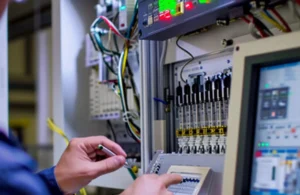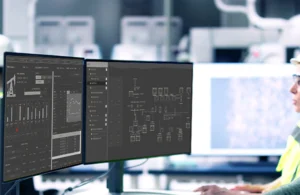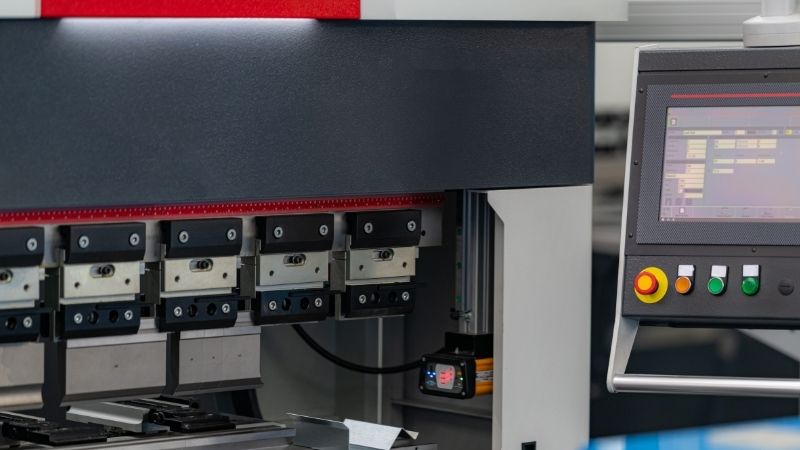Comprensión de la programación de PLC Mitsubishi: lenguajes y herramientas
Cuando se trata de PLC de Mitsubishi programación, los lenguajes principales utilizados incluyen lógica de escalera, texto estructurado y diagrama de bloques de funciones. Mitsubishi ofrece software de ingeniería de PLC especializado como GX Works2 y GX Works3, que admiten estos lenguajes, lo que permite una integración perfecta y una programación eficiente para diversas aplicaciones de automatización.
Tabla de contenido
El núcleo de la programación de PLC con Mitsubishi
Controladores lógicos programables (PLC) son la columna vertebral de la automatización industrial y controlan maquinaria y procesos en diversas industrias. Los PLC de Mitsubishi, en particular la serie MELSEC, son reconocidos por su confiabilidad y versatilidad. Comprender los lenguajes de programación que utilizan es esencial para crear soluciones de automatización eficientes y efectivas.
Lenguajes de programación de PLC Mitsubishi
Los PLC de Mitsubishi admiten varios lenguajes de programación, cada uno adecuado para diferentes tipos de aplicaciones:
- Lógica de escalera (LD):Este es el lenguaje más utilizado en la programación de PLC, similar a los diagramas lógicos de relés eléctricos. Es intuitivo para quienes tienen conocimientos de electricidad y es ideal para tareas de control sencillas.
- Texto estructurado (ET):Structured Text, un lenguaje de alto nivel similar a Pascal, es adecuado para cálculos complejos y procesamiento de datos. Ofrece mayor flexibilidad y eficiencia para tareas de automatización complejas.
- Diagrama de bloques de funciones (FBD):Este lenguaje gráfico permite la creación de bloques reutilizables, facilitando la gestión y depuración de sistemas complejos.
Utilizando GX Works2 y GX Works3
GX Works2 y GX Works3 son software de ingeniería de PLC patentado por Mitsubishi. Estas herramientas proporcionan entornos integrales para programar, depurar y administrar los PLC de Mitsubishi.
- Obras GX2Diseñado para modelos de PLC Mitsubishi más antiguos, ofrece una interfaz fácil de usar para programar en lógica de escalera y texto estructurado.
- Obras GX3:El software de próxima generación que admite los modelos de PLC más nuevos, incorpora características mejoradas como texto estructurado y una integración mejorada con otros productos de automatización de Mitsubishi.
Ambos paquetes de software facilitan la creación de programas de PLC robustos, lo que permite a los ingenieros desarrollar, probar e implementar soluciones de automatización de manera eficiente.
El papel del texto estructurado en la automatización
El texto estructurado (ST) es fundamental para gestionar tareas de automatización complejas. Su sintaxis de alto nivel permite:
- Cálculos avanzados:Realizar operaciones matemáticas complejas con facilidad.
- Manipulación de datos:Gestionar y procesar grandes conjuntos de datos de manera eficiente.
- Programación modular:Creación de bloques de código reutilizables, lo que mejora la capacidad de mantenimiento y la escalabilidad.
El uso de texto estructurado en los PLC de Mitsubishi permite el desarrollo de sistemas de control sofisticados que pueden adaptarse a diversos requisitos industriales.
Creación de un nuevo proyecto en los PLC de Mitsubishi
Iniciar un nuevo proyecto con PLC Mitsubishi implica varios pasos clave para garantizar una implementación exitosa:
- Definir los requisitos del proyecto:Describa las necesidades de automatización específicas, incluidos los puntos de entrada/salida, los protocolos de comunicación y las funcionalidades deseadas.
- Seleccione el modelo de PLC adecuado:Elija un PLC Mitsubishi que se alinee con la complejidad y la escala del proyecto.
- Configurar el entorno de desarrollo:Instalar y configurar GX Works2 o GX Works3, según el modelo de PLC.
- Diseñar la lógica de control:Utilice lógica de escalera, texto estructurado o diagrama de bloques de funciones para crear las secuencias de control necesarias.
- Prueba y depuración:Simular el programa dentro del software para identificar y corregir cualquier problema antes de la implementación.
- Implementar y monitorear:Implementar el programa en el PLC y monitorear continuamente su desempeño para garantizar un funcionamiento óptimo.
Seguir estos pasos garantiza un enfoque estructurado para la programación del PLC, minimizando errores y mejorando la confiabilidad del sistema.
Integración de módulos para una funcionalidad mejorada
Los PLC de Mitsubishi admiten varios módulos que amplían sus capacidades:
- Módulos de comunicación: Permitir la conectividad con otros dispositivos y redes, facilitando el intercambio de datos y la monitorización remota.
- Módulos de entrada/salida (E/S): Ampliar la capacidad del PLC para manejar más sensores y actuadores, aumentando la versatilidad del sistema.
- Módulos de funciones especiales: Proporciona funciones adicionales como control de movimiento, monitoreo de temperatura y más.
La integración de estos módulos en su configuración de PLC permite la creación de sistemas de automatización integrales y adaptables adaptados a necesidades industriales específicas.
Automatización industrial con PLC Mitsubishi
La aplicación de los PLC de Mitsubishi en la automatización industrial abarca diversos sectores, incluidos la fabricación, la automoción, la alimentación y bebidas, entre otros.
Su flexibilidad y sus robustas opciones de programación los hacen adecuados para tareas que van desde el simple control de máquinas hasta la automatización de procesos complejos.
Aplicaciones de PLC en las industrias modernas
- Líneas de montaje de fabricación:Automatizar la coordinación de maquinaria para mejorar la eficiencia y la consistencia de la producción.
- Sistemas de embalaje:Gestionar el proceso de envasado para garantizar la precisión y rapidez en el manejo del producto.
- Manipulación de materiales:Control de sistemas transportadores, brazos robóticos y otros equipos para agilizar la logística y reducir la intervención manual.
- Control de procesos:Regular variables como temperatura, presión y caudal para mantener condiciones operativas óptimas.
Estas aplicaciones resaltan el papel fundamental de los PLC de Mitsubishi a la hora de impulsar la productividad y garantizar la calidad en diversos entornos industriales.
Mejorando la automatización con los controladores Melsec
Melsec es la línea de PLC de Mitsubishi conocida por su alto rendimiento y escalabilidad. Ofrecen:
- PLC compactos:Ideal para aplicaciones de pequeña escala con espacio limitado.
- PLC modulares:Adecuado para sistemas más grandes que requieren amplias capacidades de E/S y funcionalidades avanzadas.
Elegir el controlador Melsec adecuado garantiza que su sistema de automatización pueda crecer y adaptarse a las cambiantes demandas industriales.
Cumplimiento de las normas IEC en la programación de PLC
El cumplimiento de las normas de la Comisión Electrotécnica Internacional (IEC) es esencial en la programación de PLC para garantizar la interoperabilidad y la seguridad.
Importancia de las normas IEC
- Normalización:Facilita la coherencia en las prácticas de programación en diferentes plataformas y fabricantes.
- Seguridad:Garantiza que los sistemas de automatización cumplan con los estrictos requisitos de seguridad, protegiendo tanto al personal como al equipo.
- Interoperabilidad:Permite una integración perfecta con otros sistemas y dispositivos que cumplen los mismos estándares.
Al seguir los estándares IEC, los ingenieros pueden desarrollar programas de PLC robustos y confiables que cumplan con los puntos de referencia de la industria global.
Mejores prácticas para la programación conforme a IEC
- Convenciones de nombres consistentes:Utilice nombres claros y descriptivos para las variables y funciones para mejorar la legibilidad del código.
- Estructura de código modular:Divida el programa en secciones manejables, lo que facilita la depuración y el mantenimiento.
- Documentación:Mantener documentación completa para proporcionar claridad sobre las funcionalidades del programa y facilitar futuras modificaciones.
La implementación de estas mejores prácticas garantiza que sus programas de PLC no solo sean compatibles, sino también eficientes y fáciles de mantener.
Preguntas frecuentes
Los PLC de Mitsubishi utilizan principalmente lógica de escalera (LD), texto estructurado (ST) y diagrama de bloques de funciones (FBD). Estos lenguajes se adaptan a distintos niveles de complejidad y requisitos de aplicación.
GX Works2 está diseñado para modelos antiguos de PLC de Mitsubishi y se centra en la programación de texto estructurado y lógica de escalera. Por el contrario, GX Works3 es compatible con modelos de PLC más nuevos y ofrece funciones mejoradas, incluida una mejor integración y compatibilidad con lenguajes de programación adicionales como el diagrama de bloques de funciones.
Sí, los PLC de Mitsubishi admiten varios protocolos de comunicación y pueden integrarse con otros sistemas de automatización. El uso de módulos de comunicación y el cumplimiento de normas como IEC facilitan la integración y el intercambio de datos sin inconvenientes.
El texto estructurado permite capacidades de programación de alto nivel, lo que lo hace adecuado para cálculos complejos, manipulación de datos y programación modular. Ofrece mayor flexibilidad y eficiencia en comparación con lenguajes gráficos como la lógica de escalera.
Tenga en cuenta factores como la complejidad de las tareas de automatización, la cantidad de puntos de E/S necesarios, las necesidades de comunicación y la escalabilidad. La serie Melsec de Mitsubishi ofrece una gama de modelos, desde PLC compactos hasta modulares, que se adaptan a distintos tamaños y requisitos de proyectos.
Potencie sus proyectos con PLC Omron, Mitsubishi y Schneider nuevos y originales: ¡en stock y listos ahora!
Conclusión
- PLC de MitsubishiUtilice lógica de escalera, texto estructurado y diagrama de bloques de funciones para una programación versátil.
- GX Works2 y GX Works3Son herramientas esenciales para desarrollar y gestionar programas de PLC.
- Texto estructuradoes ideal para tareas de automatización complejas, ofreciendo capacidades de programación de alto nivel.
- Serie Melsec de MitsubishiProporciona soluciones escalables para diversas necesidades de automatización industrial.
- Cumplimiento de las normas IECgarantiza el cumplimiento, la seguridad y la interoperabilidad en la programación de PLC.
- Integración de módulosMejora la funcionalidad y adaptabilidad de sus sistemas de automatización.
Al comprender los lenguajes de programación y las herramientas disponibles para los PLC de Mitsubishi, los ingenieros pueden diseñar e implementar soluciones de automatización sólidas que impulsan la eficiencia y la innovación en entornos industriales.
¿Buscas PLC nuevos y originales para tus proyectos? En Kwoco, tenemos en stock los PLC más recientes de las mejores marcas como Omrón, Mitsubishi, y SchneiderCompre con confianza: envío rápido, calidad garantizada. ¡Compre ahora!
Contáctenos
Simplemente complete su nombre, dirección de correo electrónico y una breve descripción de su consulta en este formulario. Nos comunicaremos con usted dentro de las 24 horas.
Categoría de producto
Productos en oferta
También te pueden interesar estos temas

Ethernet vs Modbus: ¿cuál alimenta mejor su fábrica?
Imagina que eres un gerente de compras que está seleccionando un protocolo de comunicación para conectar varios dispositivos en tu línea de producción. Si eliges el incorrecto, podrías retrasar el proyecto y afectar la calidad del producto. Entonces, ¿qué protocolo se adapta mejor a tus necesidades: Ethernet o Modbus?

Cómo se comunican eficientemente los sistemas PLC y SCADA
¿Cómo garantizan las fábricas que todos los equipos estén sincronizados, que los datos fluyan sin problemas y que se maximice la eficiencia? Aquí es donde trabajan juntos el PLC y el SCADA.

¿Cómo solucionar problemas de fuente de alimentación del PLC?
¿Cómo solucionar problemas de suministro de energía del PLC? En el mundo de la automatización industrial, una fuente de alimentación confiable es el motor






